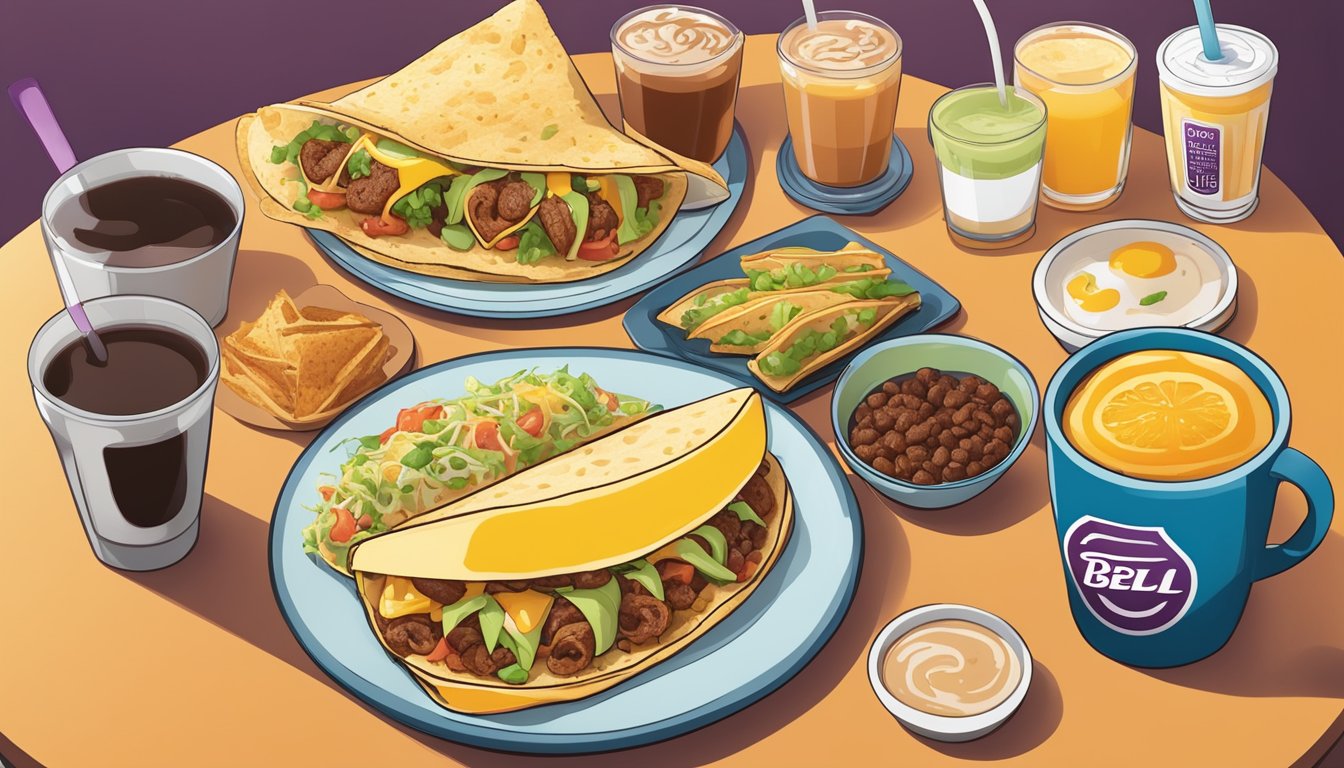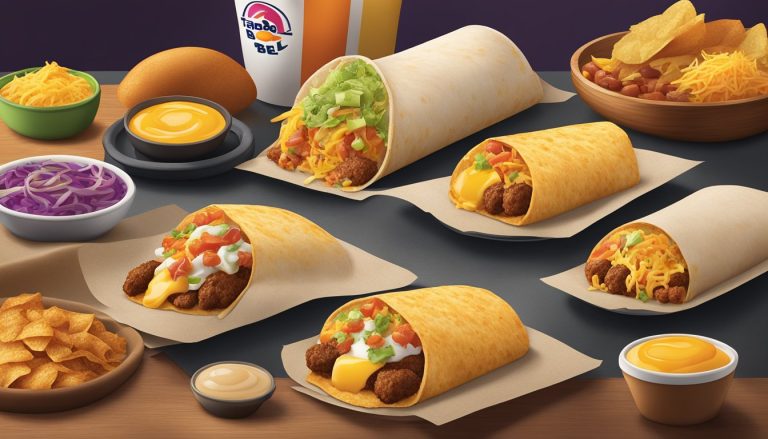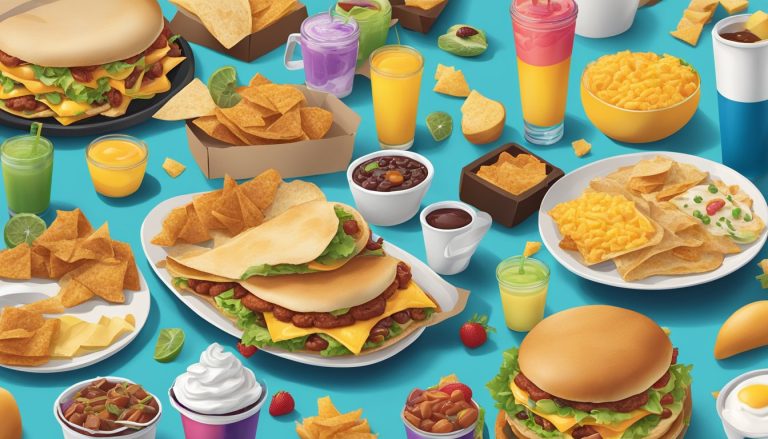Taco Bell’s foray into breakfast shook up the fast food landscape when it launched in 2014. The chain’s unique take on morning meals, featuring items like the Waffle Taco and breakfast burritos, aimed to capture the hearts and taste buds of Americans seeking something different to start their day.
Taco Bell’s decision to allow franchisees to opt out of breakfast service reflects shifting consumer habits and economic realities in the breakfast market. This move comes as the company plans to refocus its morning offerings, including an expanded coffee program and new menu items tested in corporate stores.
The evolution of Taco Bell’s breakfast menu mirrors broader changes in American eating habits. As diners increasingly seek portable, customizable options that cater to on-the-go lifestyles, fast food chains must adapt their offerings to meet these demands while balancing profitability and operational challenges.
Historical Perspective of Taco Bell’s Breakfast

Taco Bell’s journey into the breakfast market represents a significant shift in American fast food culture. The company’s entry and expansion in this space reflects changing consumer preferences and evolving morning routines.
Emergence in the Breakfast Market
Taco Bell first experimented with breakfast offerings in the late 1990s. These initial tests were limited to select locations and proved unsuccessful. The company remained undeterred, recognizing the potential in the morning meal segment.
In March 2014, Taco Bell officially launched its nationwide breakfast menu. This move marked a bold step into a fiercely competitive market dominated by established players. The timing coincided with changing work schedules and increased demand for convenient, on-the-go morning options.
Evolution of the Breakfast Menu
Taco Bell’s breakfast menu debuted with innovative items that set it apart from traditional offerings. The Waffle Taco and A.M. Crunchwrap quickly became signature dishes, appealing to customers seeking unique flavors.
Over time, the menu expanded and adapted based on customer feedback and preferences. Taco Bell introduced items like Cinnabon Delights and breakfast burritos, blending familiar breakfast elements with its distinctive Tex-Mex style.
The company focused on portability and customization, catering to the needs of busy consumers. This approach resonated with younger demographics and helped Taco Bell carve out its niche in the breakfast market.
Analyzing the American Breakfast Palate Shift
American breakfast habits have evolved significantly in recent years. Fast food chains and global culinary influences have reshaped traditional morning meal preferences, introducing new flavors and convenient options.
Influence of Fast Food on Breakfast Choices
Fast food establishments have dramatically impacted breakfast consumption patterns. Quick-serve restaurants now offer a wide array of portable breakfast items, catering to busy lifestyles. Breakfast sandwiches, wraps, and burritos have become staples for many Americans on-the-go.
These convenient options often combine familiar ingredients like eggs, cheese, and bacon in handheld formats. The emphasis on speed and portability has led to a shift away from sit-down breakfast meals.
Fast food chains have also introduced value menus and combo deals, making breakfast more accessible and affordable. This has resulted in increased breakfast consumption outside the home.
Introduction of Mexican-Inspired Breakfast Items
Mexican-inspired breakfast offerings have gained significant popularity in the American market. Breakfast burritos, in particular, have become a widespread menu item across various food establishments.
These dishes often feature a blend of eggs, cheese, meats, and vegetables wrapped in a tortilla. The versatility of Mexican-inspired breakfast items allows for customization and appeals to diverse taste preferences.
Taco Bell’s entry into the breakfast market exemplifies this trend. Their menu includes unique items like breakfast crunchwraps and quesadillas, differentiating them from traditional breakfast fare.
The integration of Mexican flavors has expanded breakfast options beyond conventional choices. Salsa, guacamole, and spicy seasonings now complement morning meals, adding new dimensions to the American breakfast palate.
Taco Bell’s Approach to Innovation and Menu Development
Taco Bell has revolutionized fast-food innovation through creative menu offerings and strategic partnerships. The company’s approach combines food trends with customer feedback to develop unique items that capture consumer interest.
Leveraging Food Trends
Taco Bell constantly monitors culinary trends to inspire new menu items. The breakfast Crunchwrap and Waffle Taco exemplify this strategy, blending familiar breakfast elements with Taco Bell’s signature style.
These innovative offerings helped Taco Bell successfully enter the competitive breakfast market. The company tested multiple breakfast concepts before finding the winning combination.
Taco Bell’s innovation lab plays a crucial role in developing new products. The team experiments with limited ingredients to create diverse menu items, maximizing creativity within constraints.
Incorporating Customer Feedback via Social Media
Social media platforms serve as valuable tools for Taco Bell to gather customer insights. The company actively engages with its audience, soliciting feedback on new and existing menu items.
This two-way communication allows Taco Bell to quickly identify popular flavors and concepts. Customer reactions to limited-time offerings often influence future menu decisions.
Taco Bell’s social media presence also generates buzz around new products. The company leverages user-generated content and viral marketing to build anticipation for innovative menu launches.
By combining trend analysis with direct customer input, Taco Bell maintains its position as a leader in fast-food innovation. This approach ensures that new menu items resonate with consumers and drive brand loyalty.
Menu Highlights and Consumer Favorites

Taco Bell’s breakfast menu features a mix of innovative creations and familiar favorites. The offerings cater to diverse tastes, balancing indulgent treats with healthier options.
Notable Breakfast Items
The Crunchwrap stands out as a breakfast icon at Taco Bell. This portable meal wraps scrambled eggs, bacon or sausage, cheese, and hash browns in a grilled tortilla. Waffle Tacos made waves when introduced, combining sweet and savory flavors in a unique handheld format.
Cinnabon Delights offer a sweet treat, featuring warm donut holes filled with Cinnabon frosting. For heartier appetites, the Grande Scrambler burrito packs eggs, cheese, potatoes, and meat into a substantial morning meal.
Healthy and Indulgent Options
Taco Bell’s breakfast menu balances indulgence with lighter fare. Healthier choices include the Mini Skillet Bowl, a low-calorie option with eggs, potatoes, and pico de gallo. The chain also offers customizable options, allowing customers to modify ingredients for dietary needs.
On the indulgent side, the Breakfast Quesaluppa combines a crispy chalupa shell with eggs, cheese, and meat. For those with a sweet tooth, the Loaded Taco Grande provides a filling start to the day with hash browns, eggs, cheese, and choice of meat.
Marketing Strategies and Digital Outreach
Taco Bell has embraced innovative marketing approaches and digital platforms to engage customers and drive breakfast sales. The company leverages social media, mobile apps, and personalized campaigns to build brand loyalty and reach new audiences.
Crafting an Effective Marketing Campaign
Taco Bell’s breakfast marketing campaigns focus on creativity and humor to capture attention. The company uses eye-catching visuals and catchy slogans across various channels. TV commercials feature enticing food shots and quirky scenarios. Billboard ads employ bold colors and simple messaging.
Social media plays a key role, with Taco Bell sharing breakfast menu items and promotions on Instagram, Twitter, and Facebook. The brand also collaborates with influencers to create buzz around new breakfast offerings. These multi-channel efforts aim to position Taco Bell as a fun, affordable breakfast option for young consumers.
Building Brand Loyalty through Digital Marketing
Taco Bell’s digital strategy centers on its mobile app and personalized outreach. The app offers exclusive deals, rewards, and convenient ordering options. Push notifications alert users to breakfast specials and limited-time offers.
Email marketing campaigns deliver targeted content based on customer preferences and purchase history. These personalized messages generate higher engagement rates. Taco Bell also uses data analytics to refine its digital marketing efforts and improve customer experiences.
The brand maintains an active social media presence, responding to customer comments and sharing user-generated content. This two-way interaction fosters a sense of community and strengthens brand loyalty among breakfast customers.
Market Response and Sales Performance

Taco Bell’s breakfast menu launch garnered significant attention and achieved strong initial sales. The fast food chain successfully carved out a niche in the competitive morning meal segment.
Capturing Market Share in the QSR Industry
Taco Bell’s breakfast offering quickly gained traction in the quick-service restaurant (QSR) industry. Within the first year, the chain captured approximately 7% of the breakfast market share. This success was partly attributed to Taco Bell’s unique menu items that differentiated them from traditional breakfast offerings.
The company’s aggressive marketing campaigns, including viral social media content and celebrity partnerships, helped drive awareness and trial. Taco Bell’s breakfast hours, typically from 6 AM to 11 AM, allowed them to compete directly with established players like McDonald’s and Burger King.
Analysis of Breakfast Sales Success
Taco Bell’s breakfast menu contributed significantly to the company’s overall sales growth. In the first year after launch, breakfast accounted for about 6% of Taco Bell’s total sales. This figure increased to 9% by the second year, indicating strong consumer acceptance and repeat purchases.
Popular breakfast items included:
- Breakfast Crunchwrap
- Cinnabon Delights
- Breakfast Quesadilla
These unique offerings resonated with younger consumers seeking alternatives to traditional breakfast fare. Taco Bell’s value-oriented pricing strategy also played a crucial role in attracting budget-conscious customers. The chain’s ability to maintain consistent quality and service during breakfast hours further solidified its position in the morning meal market.
Operational Insights

Taco Bell’s breakfast expansion required significant operational changes to accommodate new menu items and service hours. This impacted staffing, supply chains, and kitchen workflows.
Adapting to Peak Breakfast Hours
Taco Bell adjusted its operating schedule to serve breakfast from 6 AM to 11 AM. This shift necessitated earlier start times for staff and new training programs focused on breakfast preparation.
Franchisees hired additional employees to cover morning shifts. Some locations installed new equipment like griddles and coffee machines to handle breakfast orders efficiently.
Peak breakfast traffic typically occurred between 7 AM and 9 AM on weekdays. Taco Bell optimized kitchen layouts and workflows to handle the morning rush while still preparing for lunch service.
Supply Chain Management for Breakfast Offerings
Introducing breakfast items required Taco Bell to expand its supply chain network. The company sourced new ingredients like eggs, bacon, and coffee beans from reliable suppliers.
Taco Bell implemented just-in-time inventory systems for perishable breakfast ingredients to minimize waste. This approach helped maintain freshness and quality while controlling costs.
Distribution centers adjusted delivery schedules to ensure franchises received breakfast supplies before opening. Some locations required additional refrigeration and storage space to accommodate new inventory.
Taco Bell worked closely with suppliers to develop custom breakfast ingredients that aligned with its flavor profile and food preparation methods. This collaboration helped create unique offerings like the breakfast Crunchwrap.
Comparison with Competitors

Taco Bell’s breakfast menu faces stiff competition from established fast-food giants. The Mexican-inspired chain has carved out a unique niche, but must contend with longtime breakfast favorites.
Benchmarking Against Other Fast-Food Breakfasts
Taco Bell’s breakfast offerings differ significantly from traditional options. While competitors like McDonald’s and Wendy’s focus on sandwiches, Taco Bell leans into burritos and breakfast wraps.
The chain serves breakfast from 7 to 11 a.m. at most locations. This timing aligns closely with McDonald’s 6 to 11 a.m. breakfast hours.
Taco Bell’s menu features innovative items like the Breakfast Crunchwrap. This dish combines eggs, cheese, and meat in a grilled tortilla with a hash brown inside.
Other fast-food chains have expanded their breakfast menus in response. Chipotle and Qdoba now offer morning options, intensifying the competition.
The Iconic Egg McMuffin and Its Influence
McDonald’s Egg McMuffin remains a benchmark in fast-food breakfast. Introduced in 1972, it revolutionized morning dining options.
The sandwich’s simple formula – an English muffin, Canadian bacon, egg, and cheese – has inspired countless imitations. Its popularity forced other chains to innovate.
Taco Bell’s response includes items like the breakfast quesadilla. This dish aims to capture the same portable, protein-rich appeal as the McMuffin.
The Egg McMuffin’s enduring success highlights the challenge Taco Bell faces. Breaking into the breakfast market requires overcoming deeply ingrained consumer habits.
Future Outlook

Taco Bell’s breakfast strategy continues to evolve in response to changing consumer preferences and market conditions. The fast food chain is exploring new options to enhance its morning offerings and appeal to a broader customer base.
Predicting Trends in Breakfast Consumption
Breakfast habits are shifting towards more convenient, on-the-go options. Quick-service restaurants like Taco Bell are adapting by focusing on portable, easy-to-eat items. Health-conscious consumers are driving demand for more nutritious breakfast choices.
Plant-based alternatives and protein-rich options are gaining popularity. Taco Bell may introduce more vegetarian and vegan-friendly breakfast items to cater to this growing market segment. Customization is becoming increasingly important, with customers seeking personalized breakfast experiences.
Plans for New Menu Additions and Expansions
Taco Bell is ramping up its coffee program to compete with other fast food chains. The company is likely to introduce new coffee blends and flavored options to attract morning customers. Innovative breakfast items that combine Mexican-inspired flavors with traditional breakfast foods may be on the horizon.
The chain is testing new breakfast items in company-owned stores. These experiments could lead to the introduction of unique offerings that set Taco Bell apart from competitors. Expansion of breakfast hours in select locations is possible, catering to late-risers and shift workers.
Taco Bell may also explore partnerships with food delivery services to increase breakfast sales and reach customers who prefer to eat at home or work.




